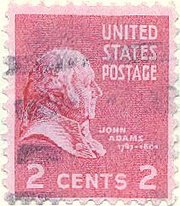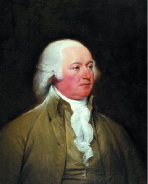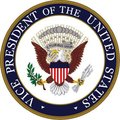John Adams
|
|
| ||
| Order: | 2nd President | |
| Vice President: | Thomas Jefferson | |
| Term of office: | March 4, 1797 – March 4, 1801 | |
| Preceded by: | George Washington | |
| Succeeded by: | Thomas Jefferson | |
| Date of birth: | October 30, 1735 | |
| Place of birth: | Braintree, Massachusetts | |
| Date of death: | July 4, 1826 | |
| Place of death: | Quincy, Massachusetts | |
| First Lady: | Abigail Adams | |
| Political party: | Federalist | |
John Adams (October 30, 1735 – July 4, 1826) was the first (1789–1797) Vice President of the United States, and the second (1797–1801) President of the United States. His son, John Quincy Adams, was the sixth President of the United States (1825–1829).
| Contents |
Biography
Adams was born on October 30 (October 19 Old Style, Julian Calendar), 1735 in Braintree, Massachusetts. His father, a farmer, also named John, was a fourth-generation descendant of Henry Adams, who emigrated from Devon, England, to Massachusetts in about 1636; his mother was Susanna Boylston Adams.
Young Adams graduated from Harvard College in 1755, and for a time taught school in Worcester and studied law in the office of James Putnam. In 1758, he was admitted to the bar. From an early age he developed the habit of writing descriptions of events and impressions of men. The earliest of these is his report of the 1761 argument of James Otis in the superior court of Massachusetts as to the legality of Writs of Assistance. Otis? argument inspired Adams with zeal for the cause of the American colonies. Years later, when he was an old man, Adams undertook to write out, at length, his recollections of this scene; it is instructive to compare the two accounts.
In 1764 Adams married Miss Abigail Smith (1744–1818), the daughter of a Congregational minister at Weymouth, Massachusetts. Their son, John Quincy Adams, was born in 1767.
Adams had none of the qualities of popular leadership of his second cousin, Samuel Adams; instead, his influence emerged through his work as a constitutional lawyer. Impetuous, intense and often vehement, Adams often found his inborn contentiousness to be a handicap in his political career. These qualities were particularly manifested at a later period—as, for example, during his term as president.
Politics
Adams first rose to influence as a leader of the Massachusetts Whigs during discussions with regard to the Stamp Act of 1765. In that year, he drafted the instructions which were sent by the town of Braintree to its representatives in the Massachusetts legislature, and which served as a model for other towns in drawing up instructions to their representatives; in August 1765 he anonymously contributed four notable articles to the Boston Gazette (republished separately in London in 1768 as A Dissertation on the Canon and Feudal Law), in which he argued that the opposition of the colonies to the Stamp Act was a part of the never-ending struggle between individualism and corporate authority; in December 1765 he delivered a speech before the governor and council in which he pronounced the Stamp Act invalid on the ground that Massachusetts, being without representation in parliament, had not assented to it.
In 1768 Adams moved to Boston. In 1770, he joined Josiah Quincy, Jr. in defending the British soldiers that were arrested and charged with the murder of four colonists during the Boston Massacre. The trial resulted in an acquittal of the officer who commanded the detachment, and most of the soldiers; but two soldiers were found guilty of manslaughter. These claimed benefit of clergy and were branded in the hand and released. Adams's conduct in taking the unpopular side in this case resulted in his subsequent election to the Massachusetts House of Representatives by a vote of 418 to 118.
Adams was a member of the Continental Congress from 1774 to 1778. In June 1775, with a view to promoting the union of the colonies, he seconded the nomination of George Washington as commander-in-chief of the army. His influence in Congress was great, and almost from the beginning he was impatient for a separation of the colonies from Great Britain. On October 5, 1775, Congress created the first of a series of committees to study naval matters. From that time onward, Adams championed the establishment and strengthening of an American Navy and is often referred to as the father of the United States Navy.
On June 7, 1776, Adams seconded the resolution introduced by Richard Henry Lee that "these colonies are, and of a right ought to be, free and independent states," acting as champion of these resolutions before the Congress until their adoption on July 2, 1776.
On June 8, 1776, he was appointed on a committee with Thomas Jefferson, Benjamin Franklin, Robert R. Livingston and Roger Sherman to draft a Declaration of Independence. Although that document was, by the request of the committee, written by Jefferson, John Adams occupied the foremost place in the debate on its adoption. Before this question had been disposed of, Adams was placed at the head of the Board of War and Ordinance, also serving on many other important committees.

Post-Continental Congress
In 1778, Adams sailed for France to supersede Silas Deane in the American commission there. However, as soon as he embarked, that commission concluded the desired treaty of alliance, and he returned home in time to be elected a member of the convention which framed the Massachusetts constitution of 1780. He penned the first draft along with James Bowdoin and Samuel Adams.
Before this work had been completed, he was chosen as minister plenipotentiary for negotiating a treaty of peace and a treaty of commerce with Great Britain and again sent to Europe in September 1779. The French government, however, did not approve of Adams? appointment and subsequently, on Charles Gravier, Comte de Vergennes? insistence, Benjamin Franklin, Thomas Jefferson, John Jay and Henry Laurens were appointed to cooperate with Adams. Since Jefferson did not leave the United States for the task and Laurens played a minor role, Jay, Adams and Franklin played the major part in the negotiations. Overruling Franklin?s vote, Jay and Adams decided to break their instructions, which required them to "make the most candid confidential communications on all subjects to the ministers of our generous ally, the king of France; to undertake nothing in the negotiations for peace or truce without their knowledge or concurrence; and ultimately to govern yourself by their advice and opinion.? Instead, they dealt directly with the British commissioners, without consulting the French ministers.
Throughout the negotiations Adams was especially determined that the right of the United States to the fisheries along the British-American coast should be recognized. Eventually the American negotiators were able to secure a favorable treaty, which was signed on November 30, 1782. Before these negotiations began, Adams had spent some time in the Netherlands. In July 1780, he had been authorized to execute the duties previously assigned to Laurens, and secured the recognition of the United States as an independent government at The Hague on April 19, 1782. During this trip he also negotiated a loan and, in October 1782, a treaty of amity and commerce, the first of such treaties between the United States and foreign powers after that of February 1778 with France.
In 1785 John Adams was appointed the first American minister to the court of St. James's. When he was presented to his former sovereign, George III, the King intimated that he was aware of Adams's lack of confidence in the French government. Adams admitted this, stating: "I must avow to your Majesty that I have no attachment but to my own country.? While in London, Adams published a work entitled A Defence of the Constitution of Government of the United States (1787), in which he repudiated the views of Turgot and other European writers as to the viciousness of the framework of state governments. In this work, he made the controversial statement that "the rich, the well-born and the able" should be set apart from other men in a senate.
Partly for this reason, Adams received only thirty-four out of sixty-nine votes in the presidential election of 1789. As this was the second largest number, he was declared vice-president. His vice-presidency was colored by the suspicion of many of his colleagues and made notable by the formation of two well-defined political groups—the Federalists (which Adams led along with Alexander Hamilton), and the Democratic-Republicans.

Presidency
In 1796, after Washington refused to seek another term, Adams was elected president, defeating Thomas Jefferson. Although Alexander Hamilton and other Federalists had asked that equal votes be cast in the electoral college for Adams and Thomas Pinckney, the other Federalist in the contest (at least in part so that Jefferson would not become vice president) Jefferson in fact came in second and attained that office. This marked the first time that the President and Vice-President were members of opposing parties. The only other time this would happen would be when Abraham Lincoln, a Republican, nominated Andrew Johnson, a Democrat, as his Vice-President in 1864.
Adams's four years as president (1797–1801) were marked by events such as the passage of the Alien and Sedition Acts, which made the Federalist Party unpopular and led to factional strife within the party itself. Adams and Hamilton became alienated, and members of Adams's own cabinet began to look to Hamilton rather than to the president as their political chief. At the time, the United States was drawn into European military affairs such as the XYZ Affair, and Adams, instead of taking advantage of the militant spirit aroused by these events, devoted himself to securing peace with France against the wishes of Hamilton and his adherents.
In 1800, Adams ran again as the Federalist presidential candidate, but distrust of him in his own party, the popular disapproval of the Alien and Sedition Acts, and the popularity of his opponent, Thomas Jefferson, caused his defeat. He then retired into private life.
Death
On July 4, 1826, the fiftieth anniversary of the adoption of the Declaration of Independence, Adams died at Quincy, after uttering the famous last words "Thomas Jefferson still survives." (Unbeknownst to Adams, Jefferson had died a few hours earlier). His crypt lies at United First Parish Church (also known as the Church of the Presidents) in Quincy. Until his record was broken by Ronald Reagan in 2001, he was the nation's longest-living President (90 years, 247 days). Despite this fact, Adams was a known hypochondriac who constantly felt he was coming down with some sort of illness.
AUTHORITIES
- C. F. Adams, The Works of John Adams, with Life (10 vols., Boston, 1850-1856)
- John and Abigail Adams, Familiar Letters during the Revolution (Boston, 1875)
- J. T. Morse, John Adams (Boston, 1885: later edition, 1899), in the American Statesmen Series
- Mellen Chamberlain, John Adams, the Statesman of the Revolution; with other Essays and Addresses (Boston, 1898). (E. CH.)
Cabinet
| OFFICE | NAME | TERM |
| President | John Adams | 1797–1801 |
| Vice President | Thomas Jefferson | 1797–1801 |
| Secretary of State | Timothy Pickering | 1797–1800 |
| John Marshall | 1800–1801 | |
| Secretary of the Treasury | Oliver Wolcott, Jr. | 1797–1800 |
| Samuel Dexter | 1800–1801 | |
| Secretary of War | James McHenry | 1797–1800 |
| Samuel Dexter | 1800–1801 | |
| Attorney General | Charles Lee | 1797–1801 |
| Postmaster General | Joseph Habersham | 1797–1801 |
| Secretary of the Navy | Benjamin Stoddert | 1798–1801 |
Supreme Court appointments
Adams appointed the following Justices to the Supreme Court of the United States. One of these appointments, that of John Marshall, was a last-minute act of retaliation for having been defeated by Thomas Jefferson. There was considerable friction between Jefferson and Marshall:
- Bushrod Washington - 1799
- Alfred Moore - 1800
- John Marshall - Chief Justice - 1801
Major presidential acts
- Signed Alien and Sedition Acts of 1798
- Signed Judiciary Act of 1801
States admitted to the Union
None
See also
Further reading
- Adams, John. The Adams Papers. Edited by Richard Ryerson, L.H. Butterfield, Marc Friedlander, et al. Cambridge, Mass.: Harvard University Press, 1961.
- Diggins, John P. John Adams. New York: Times Books, 2003.
- Ferling, John E. John Adams: A Life. 1992. Reprint, New York: Henry Holt & Co., 1996.
- McCullough, David. John Adams. New York: Simon & Schuster, 2001.
- Smith, Page. John Adams. 1962. Reprint, Collector's edition. Norwalk, Conn.: Easton Press, 1988.
- Thompson, C. Bradley. John Adams and the Spirit of Liberty. Lawrence, Kans.: University Press of Kansas, 1998.
Related articles
- U.S. presidential election, 1789
- U.S. presidential election, 1792
- U.S. presidential election, 1796
- U.S. presidential election, 1800
History Clipart and Pictures
- Pictures of the US Presidents (http://classroomclipart.com/cgi-bin/kids/imageFolio.cgi?direct=History/United_States/Presidents)
- Clipart of American Presidents (http://classroomclipart.com/cgi-bin/kids/imageFolio.cgi?direct=Clipart/American_Presidents)
- Historical Pictures of the United States (http://classroomclipart.com/cgi-bin/kids/imageFolio.cgi?direct=History/United_States)
- Pictures of the American Revolution (http://classroomclipart.com/cgi-bin/kids/imageFolio.cgi?direct=History/United_States/American_Revolution)
- Civil Rights Pictures (http://classroomclipart.com/cgi-bin/kids/imageFolio.cgi?direct=History/United_States/Civil_Rights)
- Civil War Images (http://classroomclipart.com/cgi-bin/kids/imageFolio.cgi?direct=History/United_States/Civil_War)
- Pictures of Colonial America (http://classroomclipart.com/cgi-bin/kids/imageFolio.cgi?direct=History/United_States/Colonial_America)
- Historical US Illustrations (http://classroomclipart.com/cgi-bin/kids/imageFolio.cgi?direct=History/United_States/Illustrations)
- World War II Pictures (http://classroomclipart.com/cgi-bin/kids/imageFolio.cgi?direct=History/United_States/World_War_II)
- Pictures of Historical People (http://classroomclipart.com/cgi-bin/kids/imageFolio.cgi?direct=History/United_States/People)
External links
- "Thoughts on Government" Adams, April 1776 (http://www.constitution.org/jadams/thoughts.htm)
- The Papers of John Adams (http://www.yale.edu/lawweb/avalon/presiden/adamspap.htm) from the Avalon Project (includes Inaugural Address, State of the Union Addresses, and other materials)
- Adams Family Papers: An electronic archive (http://www.masshist.org/digitaladams/aea/) Captured December 16, 2004.
- United First Parish Church (http://www.ufpc.org)
- Template:Gutenberg author



